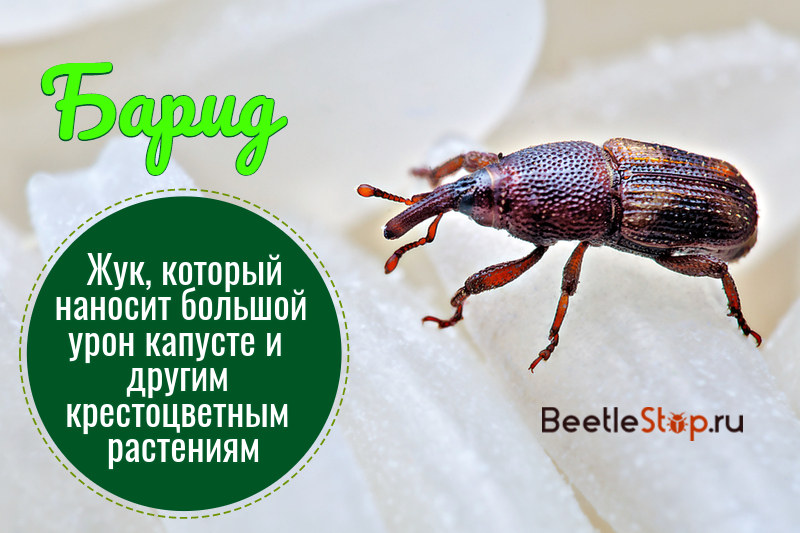Crucifer Pest - Baride: a plant-eating beetle
Barids are beetles belonging to the large family of Weevils and the order of the Coleopterans, common throughout the planet. Some of them live in Russia, Ukraine and Belarus, being familiar to humans as agricultural pests, which must be combated in order to get a quality crop.

Barides cause great damage to cruciferous plants, feeding on their tissues.
These are oblong beetles of dark colors, mostly completely painted black, often with a greenish tint. Their body is clearly divided into 2 segments: pronotum, which looks rough due to the convex points located on it, and elytra (they are 2 times longer than the pronotum), covered with longitudinal grooves that create a relief surface. Such structural features are a characteristic feature of barid beetles.
Reproduction in weevils is bisexual, occurs in the warm season. Baride eggs are oval. They are painted white matte, less often with a milky tint. The size of the eggs is 0.5–0.9 mm. Over time, light and curved larvae that have no legs hatch from them. Their body length can reach 0.5–1 cm. The pupa is also whitish, similar in size to a larva: 0.8–0.9 cm.
Kinds
Of all types of barides, like beetles eating agricultural plantations, the most significant are 3:
- Green baride. It is also called ruthenium. It got its names thanks to the green or blue-green tint of the black body and the love of planting rutabaga. The size of this beetle is small: the body is 3.5–4.5 cm long. Its rough pronotum is divided equally by a vertical strip with a smooth surface.
- Cabbage (black baride). The length of cabbage baride is from 5 to 8 mm. This species is characterized by a completely black color. The body is elongated. Although cabbage is his favorite plant for feeding and hatching larvae, the pest can also attack other cruciferous species with a feed deficiency.
- Rapeseed baride. A very small bug whose length does not exceed 3.5 mm.
Breeding
Only one generation of barid beetles per year. The process of their reproduction takes place in several stages:
- Adult beetles wait the winter in the same place where they appeared in autumn from a chrysalis. To protect themselves from the weather, a depth of 5 to 10 cm is sufficient for them, but most individuals prefer not to dig deeper than 6 cm. In some cases, the cabbage baride remains to winter in the stumps left on the sites.
- In spring, when the soil is warmed up to 8 ° C, beetles get to the surface and begin to feed on seedlings of wild-growing and cruciferous plants.
- After mating, the female makes masonry at the root neck of the plantings. This usually happens from May to July, depending on climatic conditions and weather. Each of the females is able to lay 100 eggs.
- After 7–10 days, legless larvae hatch from the eggs, moving into the stem of the plant. They begin to gnaw juicy flesh, gaining their own body weight and preparing to turn into a chrysalis. Barides are in the larval stage for about a month.
- Pupation occurs inside plants. At this stage, the temperature regime is very important: for the development to proceed successfully, the air temperature should not fall below 20 ° C.In colder weather, the conversion process slows down, and when the average daily temperature drops to 12 ° C, it stops completely. If the chrysalis did not manage to become a bug in time, then it will die from the winter cold. In favorable conditions, it is enough for 20-30 days to become an adult.
- Beetles are selected from plants and burrow into the ground, where they will winter.
Harm
The beetle, climbing out of the ground in spring, begins to feed on weeds, and then young agricultural crops of cruciferous plants: cabbage, rutabaga, and rape. It eats buds, leaves, shoots and the root neck. Larvae gnaw the plant from the inside, eating away its trunk.
Plantations are harmed by both adult barids and larvae.
Ways to fight
Baride control is necessary to get a good harvest. Agrotechnical measures will help prevent pest infection:
- deep autumn digging of the site;
- removal of weeds, especially those belonging to the cruciferous family;
- cleaning cabbage stumps, because beetles will hide in them.
- crop rotation: it is not recommended to grow cruciferous plants in the same place constantly.
If this is not enough and the plants are seriously damaged, radical destruction methods are used: the use of insecticides. Suitable organophosphorus compounds, pyrethroids and neoniettinoids. They produce two spraying procedures: at the time of the release of beetles and after 14 days.
Unfortunately, not all growers are aware of the dangers of barides. Knowing about this possible threat, you can take action in time and avoid its consequences.


 (votes: 2, average rating: 4,50 out of 5)
(votes: 2, average rating: 4,50 out of 5)